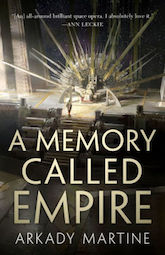At the time of this writing, Gentleman Jole and the Red Queen is the last book in the Vorkosigan series. It was released in 2016. As almost always, we will start with the cover.
Gentleman Jole has only one cover. I have located a version with the title in Bulgarian (thank you, ISFDB), but it has the same art. The art is by Ron Miller, who has had a long career painting lots of science fiction book covers, based on a design by Bujold herself. This is the perfect genesis for a book cover.
I don’t like it.
The twining strands of DNA suggest that the book is going to be about a super-secret, incredibly out-of-character, Barrayaran genetic engineering project, or biological warfare. And it’s, you know, not. In fairness, there are three strands of DNA, which makes sense when you read the book and find out what it’s about, but the significance isn’t clear from anything on the cover.
Everything that is on this cover frustrates me. I don’t like the plot synopsis on the cover flap either. It says Imperial Auditor Miles Vorkosigan has to investigate his own mother, which makes it sound vaguely like Cordelia might have cheated on her taxes. I don’t like the frontispiece by Dave Seeley. It’s a landscape with river and lightflyer—science fiction in nature! Nothing about this seems to be Sergyaran. We don’t even get Rosemont’s grave marker. It’s like Baen constructed a marketing campaign with the goal of obfuscating any hint of what this book actually is. In fact, they did not. At least, if they tried to, they were foiled by Lois McMaster Bujold being very, very clear on what the book was about in the press releases, which I read as the situation developed. I did not go in to this book blind. I knew. Everyone who knew the book was coming knew. You would have had to read the first headline about the book and then hide under a rock for six months to not know.
In the future, when people who don’t remember stalking new book releases in 2016 find the Vorkosigan Saga and read it straight through to the end, some of them are in for a really big surprise. They’ll be fine. It will be good for them. I just wish it was okay for this book to flaunt its girl cooties. When humanity goes into space, it’s going to take all the baggage surrounding its love life with it. There’s a huge audience that is completely open, honest, and forthright about its desire to read all about that, and they buy a lot of books. If they knew what this book was about, more of that audience might recognize it as something they want to read. There’s a party in this book and that audience would want to know about it. This cover is kind of an un-inivitation.
I would love to see what Esad Ribic would do for this—I’m imagining a lurid threesome with a lot of muscles and a complete lack of shirts. I think Martina Pilcerova would do something gorgeous. We’ve had some amazing abstract covers from Spain and I’d love to see one of those artists take this on. I hope that one day there will be a Japanese edition that features Jole and Cordelia in gorgeous, flowy, layered clothing in the wilderness of Sergyar, near some radially symmetrical organisms. Not the ones that sting. Some other ones. Maybe one day Gentleman Jole will be part of a new Cordelia-centric omnibus edition and we’ll get a collage of pivotal moments in Cordelia’s story. My fingers are crossed and my breath is held.
Inside the book, Admiral Oliver Jole surveys the Command-and-Control center on his space station. It’s boring. I’m glad. There are two kinds of situations that arise on space stations: boring ones, and ones where a lot of people die. It’s early in the book for a lot of people to die. Not unheard of, but early. Jole is not entirely bored, because the Vicereine is coming home. And here to help him reminisce about his career, a career we have heard of on the fringes of the background on a few previous occasions but never really had the chance to delve in to, is the next generation of the Barrayaran Military, Lieutenant Kaya Vorinnis of the Imperial Service Women’s Auxiliary.
Buy the Book


A Memory Called Empire
She’s almost twenty-three.
You know what we call people who are almost twenty-three?
Twenty-two. We call them twenty-two.
When I was twenty-two, this book wasn’t even out yet.
By the time Miles was twenty-two, he had taken over a mercenary company, faced criminal charges, completed his education at the Imperial Military Academy, participated in a mutiny, spent a month in ImpSec custody, and played a pivotal role in the War of Hegen Hub So I guess you can cram a lot into twenty-two years if you’re short and hyperactive. Vorinnis has not had Miles’s advantages, being a) a Barrayaran woman and b) nowhere near as well-connected. She’s not High Vor. She’s only met Count Vorinnis twice. She yearns for ship duty.
I love her.
Lt. Vorinnis needs Admiral Jole’s life story. In addition to his administrative experience as aide to Aral Vorkosigan during Aral’s time as Prime Minister (after the Regency), Jole served three tours on trade fleet escort duty. His only service in a shooting war was with Aral in the War of Hegen Hub. Jole was eight years old when the War of Vordarian’s Pretendership ended.
On this occasion, Cordelia is, once again, carrying a container that could theoretically contain a severed head, one that she declines to hand off to any of the available retainers—Jole’s or her own. She proceeds immediately down to the planet’s surface, pausing only to tell Jole—whose first name is Oliver—that her secretary will be in touch to schedule lunch when Jole is downside in the next week.
At lunch, Cordelia reveals that her relationship with Jole, and Aral’s, has long been more than merely professional. She knows how far down his blush goes. Professionally, Aral, Cordelia and Jole functioned as a trio prior to Aral’s death. In keeping with her expectation of living well past a century, and with the plans she made before Aral was Regent for Gregor and the soltoxin attack changed so much, Cordelia is planning to have children. She and Aral froze some gametes, long long ago. Her public health projects on Sergyar have included the construction of a replicator center in Kareenburg, the current capital. She’s planning daughters, which avoids certain Barrayaran legal complications. She’s picked out names. Cordelia is planning a future Naismith family—she’s using Kosigan as a middle name but no Vor anywhere, to avoid making them targets. She called this meeting to tell Oliver she’s pregnant—or about to be, via the widely-available miracle of uterine replicators.
And she’s offering him children too. She has four enucleated eggshells and additional sperm from Aral. Oliver and Aral, longtime lovers, could have children of their own. The biology and technology are available, and even standard, in most of the Galactic Nexus. I don’t know how standard the romantic relationship the three of them shared would be. Bujold’s description of Aral falling in love with Jole is gorgeous and evocative—like being hit by a falling building. Not a building falling over—a building falling from the sky. It conveys a sense of inescapability, and a sense of terror, and somehow also a sense that maybe we could all fall in love a little harder and a little more deeply.
In his essay on Sisyphus, Camus pondered the question of how humanity should react to the absurdity of life. He proposed that we should revolt against it. All of us are pushing our own rocks up our own hills because of our stubborn and counterfactual insistence on finding meaning in our rocks and hills. With her retirement approaching, Cordelia is trading her rock and her hill for new ones. She makes her offer to Jole not because there’s anything fundamentally wrong with the rock/hill pair going on in his life, but because she thinks he deserves more, and she thinks he should think so too. She thinks Jole should be greedier.
Jole declines to provide the details of his early courtship with Aral—he says the standard for declassification is fifty years. Jole doesn’t consider all of his personal adventures classified; he reminisces a little about a Betan herm merchanter he met on a trade fleet escort tour. He doesn’t name the merchanter now but the Galactic Nexus is not arbitrary and absurd, and we will hear about this again.
Ellen Cheeseman-Meyer teaches history and reads a lot.










